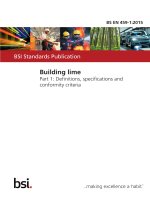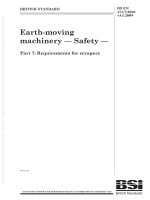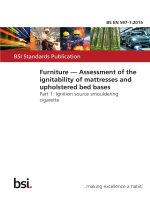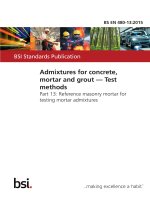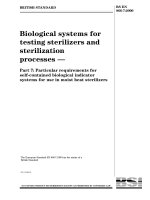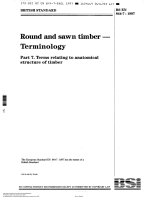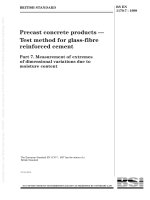Bsi bs en 62379 7 2015
Bạn đang xem bản rút gọn của tài liệu. Xem và tải ngay bản đầy đủ của tài liệu tại đây (1.79 MB, 62 trang )
BS EN 62379-7:2015
BSI Standards Publication
Common control interface
for networked digital audio
and video products
Part 7: Measurements
BRITISH STANDARD
BS EN 62379-7:2015
National foreword
This British Standard is the UK implementation of EN 62379-7:2015. It is
identical to IEC 62379-7:2015.
The UK participation in its preparation was entrusted to Technical
Committee EPL/100, Audio, video and multimedia systems and equipment.
A list of organizations represented on this committee can be obtained on
request to its secretary.
This publication does not purport to include all the necessary provisions of
a contract. Users are responsible for its correct application.
© The British Standards Institution 2015.
Published by BSI Standards Limited 2015
ISBN 978 0 580 81634 5
ICS 33.160.01; 35.100.01
Compliance with a British Standard cannot confer immunity from
legal obligations.
This British Standard was published under the authority of the
Standards Policy and Strategy Committee on 31 August 2015.
Amendments/corrigenda issued since publication
Date
Text affected
BS EN 62379-7:2015
EUROPEAN STANDARD
EN 62379-7
NORME EUROPÉENNE
EUROPÄISCHE NORM
August 2015
ICS 33.160; 35.100
English Version
Common Control Interface for networked digital audio and video
products - Part 7: Measurements
(IEC 62379-7:2015)
Interface de commande communne destinée aux produits
audio et video numériques connectés en réseau - Partie 7 :
Mesures
(IEC 62379-7:2015)
Gemeinsame Steuerschnittstelle für netzwerkbetriebene
digitale Audio- und Videogeräte - Teil 7: Messungen
(IEC 62379-7:2015)
This European Standard was approved by CENELEC on 2015-07-21. CENELEC members are bound to comply with the CEN/CENELEC
Internal Regulations which stipulate the conditions for giving this European Standard the status of a national standard without any alteration.
Up-to-date lists and bibliographical references concerning such national standards may be obtained on application to the CEN-CENELEC
Management Centre or to any CENELEC member.
This European Standard exists in three official versions (English, French, German). A version in any other language made by translation
under the responsibility of a CENELEC member into its own language and notified to the CEN-CENELEC Management Centre has the
same status as the official versions.
CENELEC members are the national electrotechnical committees of Austria, Belgium, Bulgaria, Croatia, Cyprus, the Czech Republic,
Denmark, Estonia, Finland, Former Yugoslav Republic of Macedonia, France, Germany, Greece, Hungary, Iceland, Ireland, Italy, Latvia,
Lithuania, Luxembourg, Malta, the Netherlands, Norway, Poland, Portugal, Romania, Slovakia, Slovenia, Spain, Sweden, Switzerland,
Turkey and the United Kingdom.
European Committee for Electrotechnical Standardization
Comité Européen de Normalisation Electrotechnique
Europäisches Komitee für Elektrotechnische Normung
CEN-CENELEC Management Centre: Avenue Marnix 17, B-1000 Brussels
© 2015 CENELEC All rights of exploitation in any form and by any means reserved worldwide for CENELEC Members.
Ref. No. EN 62379-7:2015 E
BS EN 62379-7:2015
EN 62379-7:2015
European foreword
The text of document 100/2168/CDV, future edition 1 of IEC 62379-7, prepared by IEC/TC 100, "Audio,
video and multimedia systems and equipment" was submitted to the IEC-CENELEC parallel vote and
approved by CENELEC as EN 62379-7:2015.
The following dates are fixed:
•
•
latest date by which the document has
to be implemented at national level by
publication of an identical national
standard or by endorsement
latest date by which the national
standards conflicting with the
document have to be withdrawn
(dop)
2016-04-21
(dow)
2018-07-21
Attention is drawn to the possibility that some of the elements of this document may be the subject of
patent rights. CENELEC [and/or CEN] shall not be held responsible for identifying any or all such patent
rights.
Endorsement notice
The text of the International Standard IEC 62379-7:2015 was approved by CENELEC as a European
Standard without any modification.
In the official version, for Bibliography, the following note has to be added for the standard indicated:
IEC 62379 (series)
2
NOTE
Harmonized as EN 62379 (series).
BS EN 62379-7:2015
EN 62379-7:2015
Annex ZA
(normative)
Normative references to international publications
with their corresponding European publications
The following documents, in whole or in part, are normatively referenced in this document and are
indispensable for its application. For dated references, only the edition cited applies. For undated
references, the latest edition of the referenced document (including any amendments) applies.
NOTE 1 When an International Publication has been modified by common modifications, indicated by (mod), the relevant EN/HD
applies.
NOTE 2 Up-to-date information on the latest versions of the European Standards listed in this annex is available here:
www.cenelec.eu.
Publication
IEC 62379-1
Year
-
IEC 62379-2
2008
IEC 62379-3
-
Title
Common control interface for networked
digital audio and video products -- Part 1:
General
Common control interface for networked
digital audio and video products -- Part 2:
Audio
Common control interface for networked
digital audio and video products -- Part 3:
Video
EN/HD
EN 62379-1
Year
-
EN 62379-2
2009
EN 62379-3
-
3
–2–
BS EN 62379-7:2015
IEC 62379-7:2015 © IEC 2015
CONTENTS
FOREWORD ......................................................................................................................... 5
INTRODUCTION ................................................................................................................... 7
1
Scope .......................................................................................................................... 10
2
Normative references................................................................................................... 10
3
Terms, definitions and abbreviations ............................................................................ 10
3.1
Terms and definitions .......................................................................................... 10
3.2
Abbreviations ...................................................................................................... 10
4
Audio format definitions ............................................................................................... 11
5
Video format definitions ............................................................................................... 11
6
MIB definitions for measurement information blocks ..................................................... 11
6.1
General ............................................................................................................... 11
6.2
Type definitions ................................................................................................... 12
6.2.1
General ....................................................................................................... 12
6.2.2
Textual conventions ..................................................................................... 12
6.2.3
Sequences ................................................................................................... 13
6.3
Network measurement information blocks ............................................................ 14
6.3.1
Network measurement information block structure ........................................ 14
6.3.2
nMtBlockTable ............................................................................................. 15
6.3.3
nMtBlockEntry .............................................................................................. 15
6.3.4
nMtBlockId ................................................................................................... 15
6.3.5
nMtIfIndex .................................................................................................... 15
6.3.6
nMtTxRxPoint .............................................................................................. 15
6.3.7
nMtNetworkType .......................................................................................... 16
6.3.8
nMtTransportType ........................................................................................ 16
6.3.9
nMtTxRxAddr ............................................................................................... 16
6.3.10
nMtPortNumber ............................................................................................ 16
6.3.11
nMtIGMPVersion .......................................................................................... 16
6.3.12
nMtSIPServerAddr ....................................................................................... 16
6.4
Audio measurement information blocks ................................................................ 17
6.4.1
Audio measurement information block structure ............................................ 17
6.4.2
aMtBlockTable ............................................................................................. 17
6.4.3
aMtBlockEntry .............................................................................................. 17
6.4.4
aMtBlockId ................................................................................................... 18
6.4.5
aMtAudioComponentNumber ........................................................................ 18
6.4.6
aMtNetworkBlockId ...................................................................................... 18
6.4.7
aMtAudioStatus ............................................................................................ 18
6.4.8
aMtAudioSignalFormat ................................................................................. 18
6.4.9
aMtAudioPId ................................................................................................ 18
6.4.10
aMtIfIndex .................................................................................................... 18
6.4.11
aMtFECType ................................................................................................ 19
6.4.12
aMtFECLengthDimension ............................................................................. 19
6.5
Video measurement information blocks ................................................................ 19
6.5.1
Video measurement information block structure ............................................ 19
6.5.2
vMtBlockTable ............................................................................................. 20
BS EN 62379-7:2015
IEC 62379-7:2015 © IEC 2015
–3–
6.5.3
vMtBlockEntry .............................................................................................. 20
6.5.4
vMtBlockId ................................................................................................... 20
6.5.5
vMtAudioBlockId .......................................................................................... 20
6.5.6
vMtNetworkBlockId ...................................................................................... 20
6.5.7
vMtVideoStatus ............................................................................................ 20
6.5.8
vMtVideoSourceFormat ................................................................................ 20
6.5.9
vMtVideoCodingType ................................................................................... 21
6.5.10
vMtVideoBitRateType ................................................................................... 21
6.5.11
vMtVideoBitRate .......................................................................................... 21
6.5.12
vMtVideoAspectRatio ................................................................................... 21
6.5.13
vMtFECType ................................................................................................ 21
6.5.14
vMtFECLengthDimension ............................................................................. 21
6.5.15
vMtTrickModeSupport .................................................................................. 21
6.6
Receiver point measurement information block .................................................... 21
6.6.1
Receiver measurement information block structure ....................................... 21
6.6.2
rxPointTable ................................................................................................ 22
6.6.3
rxPointEntry ................................................................................................. 23
6.6.4
rxPointBlockId .............................................................................................. 23
6.6.5
rxPointNetworkBlockId ................................................................................. 23
6.6.6
rxPointBufferSize ......................................................................................... 23
6.6.7
rxPointBufferOcpancyTime ........................................................................... 23
6.6.8
rxPointBufferOcpncyPcnt ............................................................................. 23
6.6.9
rxPointMDI ................................................................................................... 23
6.6.10
rxPointTSDF ................................................................................................ 23
6.7
Temperature measurement information block ....................................................... 23
6.7.1
Temperature measurement information block structure ................................. 23
6.7.2
temperatureTable ......................................................................................... 24
6.7.3
temperatureEntry ......................................................................................... 24
6.7.4
temperatureBlockId ...................................................................................... 24
6.7.5
temperatureLocnNumber .............................................................................. 25
6.7.6
temperatureLocation .................................................................................... 25
6.7.7
temperatureTrend ........................................................................................ 25
6.7.8
temperatureStatus ....................................................................................... 25
6.7.9
temperatureLowWarning .............................................................................. 25
6.7.10
temperatureHighWarning .............................................................................. 25
6.7.11
temperatureLowCritical ................................................................................ 25
6.7.12
temperatureHighCritical ................................................................................ 25
Annex A (informative) Machine-readable measurement block definitions ............................. 26
Annex B (informative) Machine-readable textual conventions definitions ............................. 44
Annex C (informative) Worked example .............................................................................. 48
C.1
Overview............................................................................................................. 48
C.2
Example 1 ........................................................................................................... 48
C.2.1
General ....................................................................................................... 48
C.2.2
Block table ................................................................................................... 48
C.2.3
Mixer block .................................................................................................. 50
C.2.4
Multiple functionality device .......................................................................... 51
C.2.5
Summary of tables ....................................................................................... 54
Bibliography ....................................................................................................................... 55
–4–
BS EN 62379-7:2015
IEC 62379-7:2015 © IEC 2015
Figure 1 – Relationships between ECN groups ACIP, VCIP and IPM ...................................... 8
Figure 2 – Network measurement information block ............................................................. 14
Figure 3 – Audio measurement information block ................................................................. 17
Figure 4 – Video measurement information block ................................................................. 19
Figure 5 – Receiver measurement information block ............................................................ 22
Figure 6 – Temperature measurement information block ...................................................... 24
Figure C.1 – Example of a modified audio device................................................................. 48
Figure C.2 – Annotated connector diagram .......................................................................... 49
Figure C.3 – Mixer section .................................................................................................. 50
Figure C.4 – Single device with multiple functionality ........................................................... 52
Figure C.5 – Measurement blockIds and their associated media components ....................... 52
Figure C.6 – Single device with multiple functionality ........................................................... 53
Table 1 – Managed objects for network measurement information blocks ............................. 15
Table 2 – Managed objects for audio measurement information blocks ................................. 17
Table 3 – Managed objects for video measurement information blocks ................................. 20
Table 4 – Managed objects for receiver measurement information blocks ............................. 22
Table 5 – Managed objects conveying temperature information about the unit ...................... 24
Table C.1 – Main block Id table ........................................................................................... 49
Table C.2 – Mixer related block Id table .............................................................................. 50
Table C.3 – Mixer block tables ............................................................................................ 51
Table C.4 – Addition of measurement block Ids .................................................................. 52
Table C.5 – Video measurement table ................................................................................. 53
Table C.6 – Network measurement table ............................................................................. 53
Table C.7 – Audio measurement table ................................................................................. 53
Table C.8 – Table summary ................................................................................................ 54
BS EN 62379-7:2015
IEC 62379-7:2015 © IEC 2015
–5–
INTERNATIONAL ELECTROTECHNICAL COMMISSION
____________
COMMON CONTROL INTERFACE FOR NETWORKED
DIGITAL AUDIO AND VIDEO PRODUCTS –
Part 7: Measurements
FOREWORD
1) The International Electrotechnical Commission (IEC) is a worldwide organization for standardization comprising
all national electrotechnical committees (IEC National Committees). The object of IEC is to promote
international co-operation on all questions concerning standardization in the electrical and electronic fields. To
this end and in addition to other activities, IEC publishes International Standards, Technical Specifications,
Technical Reports, Publicly Available Specifications (PAS) and Guides (hereafter referred to as “IEC
Publication(s)”). Their preparation is entrusted to technical committees; any IEC National Committee interested
in the subject dealt with may participate in this preparatory work. International, governmental and nongovernmental organizations liaising with the IEC also participate in this preparation. IEC collaborates closely
with the International Organization for Standardization (ISO) in accordance with conditions determined by
agreement between the two organizations.
2) The formal decisions or agreements of IEC on technical matters express, as nearly as possible, an international
consensus of opinion on the relevant subjects since each technical committee has representation from all
interested IEC National Committees.
3) IEC Publications have the form of recommendations for international use and are accepted by IEC National
Committees in that sense. While all reasonable efforts are made to ensure that the technical content of IEC
Publications is accurate, IEC cannot be held responsible for the way in which they are used or for any
misinterpretation by any end user.
4) In order to promote international uniformity, IEC National Committees undertake to apply IEC Publications
transparently to the maximum extent possible in their national and regional publications. Any divergence
between any IEC Publication and the corresponding national or regional publication shall be clearly indicated in
the latter.
5) IEC itself does not provide any attestation of conformity. Independent certification bodies provide conformity
assessment services and, in some areas, access to IEC marks of conformity. IEC is not responsible for any
services carried out by independent certification bodies.
6) All users should ensure that they have the latest edition of this publication.
7) No liability shall attach to IEC or its directors, employees, servants or agents including individual experts and
members of its technical committees and IEC National Committees for any personal injury, property damage or
other damage of any nature whatsoever, whether direct or indirect, or for costs (including legal fees) and
expenses arising out of the publication, use of, or reliance upon, this IEC Publication or any other IEC
Publications.
8) Attention is drawn to the Normative references cited in this publication. Use of the referenced publications is
indispensable for the correct application of this publication.
9) Attention is drawn to the possibility that some of the elements of this IEC Publication may be the subject of
patent rights. IEC shall not be held responsible for identifying any or all such patent rights.
International Standard IEC 62379-7 has been prepared by technical area 4: Digital system
interfaces and protocols of IEC technical committee 100: Audio, video and multimedia
systems and equipment.
The text of this standard is based on the following documents:
CDV
Report on voting
100/2168/CDV
100/2338/RVC
Full information on the voting for the approval of this standard can be found in the report on
voting indicated in the above table.
This publication has been drafted in accordance with the ISO/IEC Directives, Part 2.
–6–
BS EN 62379-7:2015
IEC 62379-7:2015 © IEC 2015
A list of all parts in the IEC 62379 series, published under the general title Common control
interface for networked digital audio and video products, can be found on the IEC website.
The committee has decided that the contents of this publication will remain unchanged until
the stability date indicated on the IEC website under "" in the data
related to the specific publication. At this date, the publication will be
•
reconfirmed,
•
withdrawn,
•
replaced by a revised edition, or
•
amended.
A bilingual version of this publication may be issued at a later date.
IMPORTANT – The 'colour inside' logo on the cover page of this publication indicates
that it contains colours which are considered to be useful for the correct
understanding of its contents. Users should therefore print this document using a
colour printer.
BS EN 62379-7:2015
IEC 62379-7:2015 © IEC 2015
–7–
INTRODUCTION
IEC 62379 specifies the common control interface, a protocol for managing equipment which
conveys audio and/or video across digital networks.
An introduction to the common control interface is given in IEC 62739-1.
This part of IEC 62379 specifies those aspects that are specific for using the block structure
as defined in IEC 62379-1, for standardising the collection method of audio and video
parameters for use by the European Broadcasting Union Expert Communities Networks –
Internet Protocol (IP) Measurements (EBU ECN-IPM) Group.
The collection of network related parameters may be outside the scope of this standard.
These are expected to be collected from the standard Internet Engineering Task Force (IETF)
Management Information Base (MIBs) that are generally present in most (if not all) networked
equipment. Some specific network parameters are included that are not obtainable from
existing standard IETF MIBs.
Structure of the family of standards
IEC 62379 specifies the common control interface, a protocol for managing networked
audiovisual equipment. It is intended to include the following Parts:
Part 1: General
Part 2: Audio
Part 3: Video
Part 4: Data
Part 5: Transmission over networks
Part 6: Packet transfer service
Part 7: Measurement
Part 1 specifies aspects which are common to all equipment.
Parts 2 to 4 specify control of internal functions specific to equipment carrying particular types
of live media. Part 4 does not refer to packet data such as the control messages themselves.
Part 5 specifies control of transmission of these media over each individual network
technology. It includes network specific management interfaces along with network specific
control elements that integrate into the control framework.
Part 6 specifies carriage of control and status messages and non-audiovisual data over
transports that do not support audio and video, such as RS232 serial links, with (as with Part
5) a separate subpart for each technology.
Part 7 specifies those aspects that are specific to the measurement requirements of the EBU
ECN-IPM Group.
An introduction to the common control interface is given in IEC 62739-1.
Description, aims and requirements of the EBU ECN-IPM Group
In recent years, EBU members have been increasingly adopting IP networks for the
contribution of audio and video in real-time. It is well known that although IP networks are of
lower cost and provide more flexibility compared with circuit switched networks, they suffer
–8–
BS EN 62379-7:2015
IEC 62379-7:2015 © IEC 2015
from longer delays and have much larger jitter, while broadcasters’ tolerance to these
variables is much less than that of normal business IT traffic.
To respond to Members’ use of IP, EBU set up two groups, Expert Communities Networks
Audio contribution over IP (ECN-ACIP) and Expert Communities Networks − Video
contribution over IP (ECN-VCIP), with the tasks of drawing up recommended codes of
practice 1.
Adaptation layer A/V over IP – Recommendations N/ACIP and N/VCIP
Application information exchange
Measurement of network performance between connection
points defined by N/IPM
Network information exchange
Contractual relation
agreement on QoS
A/V
IP
A/V
IP
Network
IEC
Figure 1 – Relationships between ECN groups ACIP, VCIP and IPM
It was also recognised that there would be a strong demand for tools that would enable
broadcasters to measure and manage their IP networks properly to suit the many time-critical
broadcast applications they would be subjected to. To this end, the ECN-IPM (IP
measurement) group was set up. The relationships between these three groups are shown in
Figure 1.
The goals of ECN-IPM Group were to
–
define a quality of service classification to achieve requested A/V transmission quality for
broadcast applications,
–
standardise network information exchange between EBU members and Telecom suppliers,
–
propose a method of collecting end-to-end performance information for management
purposes.
In achieving these goals the ECN-IPM Group has specified a set of parameters that are
important for broadcasters when using IP networks for audio and video transmission and has
developed a software mechanism to probe a network for device and topology discovery,
physical path tracing for both end-to-end communication and multicast streams, with the
potential for multilayer monitoring for streams on a multi-vendor network with fully mediaspecific parameters.
The specified parameters cover both the network layer and application layer (for video and
audio). SNMP is employed to collect information on the status of networked devices, such as
the transmission rate, error rate, the codec used and multicast streams status.
___________
1
ECN-ACIP and ECN-VCIP were formerly known as N/ACIP and N/VCIP respectively.
BS EN 62379-7:2015
IEC 62379-7:2015 © IEC 2015
–9–
To ensure that all the parameters can be recovered from a variety of different manufacturers’
IP equipment, the group has designed a Management Information Base (MIB). Although many
MIB files have been published over the years, especially on the network side, very little
standardisation work has been done on Audio/Video (A/V) codec MIB files. The EBU ECNIPM Group has therefore proposed a new standard, based upon the IEC 62379 series to
address this issue.
Two EBU technical publications have been produced by the ECN-IPM Group.
The parameters and new MIB information may be found in EBU-Tech 3345, End-to-End IP
Network Measurement for Broadcast Applications – Parameters & Management Information
Base (MIB), Geneva, July 2011.
A description of the software mechanism, EisStream 2, may be found in EBU-Tech 3346, Endto-End IP Network Measurement for Broadcast Applications – EisStream Software package
description, Geneva, July 2011. The software is written in Java and it provides physical path
tracing for IP traffic using SNMP.
This part of IEC 62379 and other related parts of IEC 62379, constitute the standards upon
which Section 3 of EBU-Tech 3345 is based.
If there is any inconsistency between this standard and Section 3 of EBU-Tech 3345, then
IEC 62379-7 and other related parts of IEC 62379, take precedence.
___________
2
EBU Integrated Monitoring Solution for Media Streams on IP Networks, />
– 10 –
BS EN 62379-7:2015
IEC 62379-7:2015 © IEC 2015
COMMON CONTROL INTERFACE FOR NETWORKED
DIGITAL AUDIO AND VIDEO PRODUCTS –
Part 7: Measurements
1
Scope
This part of IEC 62379 specifies aspects of the common control interface of IEC 62379-1 that
are specific to the measurement of the service experienced by audio and video streams and
in particular to the requirements of EBU ECN-IPM Measurements Group.
2
Normative references
The following documents, in whole or in part, are normatively referenced in this document and
are indispensable for its application. For dated references, only the edition cited applies. For
undated references, the latest edition of the referenced document (including any
amendments) applies.
IEC 62379-1, Common control interface for networked digital audio and video products –
Part 1: General
IEC 62379-2:2008, Common control interface for networked digital audio and video products –
Part 2: Audio
IEC 62379-3, Common control interface for networked audio and video products – Part 3: Video
3
Terms, definitions and abbreviations
3.1
Terms and definitions
For the purposes of this document, the terms and definitions given in IEC 62379-1 and
IEC 62379-2 apply.
3.2
Abbreviations
ASI
Asynchronous Serial Interface
DF
Delay Factor
FEC
Forward Error Correction
HD
High Definition
IGMP
Internet Group Management Protocol
MDI
Media Delivery Index
MIB
Management Information Base
MLR
Media Loss Rate
OID
Object IDentifier
PID
Programme ID
RTP
Real-Time Protocol
SD
Standard Definition
SIP
Session Initiation Protocol
SNMP
Simple Network Management Protocol
TS-DF
Time Stamped Delay Factor
BS EN 62379-7:2015
IEC 62379-7:2015 © IEC 2015
4
– 11 –
Audio format definitions
At any point in the audio signal chain, the audio data will be in a particular format. For
management purposes, the format shall be identified by an object identifier, either a “Common
control interface standard” object identifier as defined and specified in IEC 62379-2 or an
object identifier defined elsewhere.
NOTE 1 Permitting audio format identifiers to be defined outside this standard allows use of proprietary formats
within the standard protocol and also allows industry standard formats to emerge that may eventually be
incorporated into future revisions of this standard.
NOTE 2 The audio signal format definitions specified in IEC 62379-2 are used in a common manner by both audio
only units and the one or more audio components associated with a video flow.
5
Video format definitions
At any point in the video signal chain, the video data will be in a particular format. For
management purposes, the format should be identified by an object identifier, either a
“Common control interface standard” object identifier as defined and specified in IEC 62379-3
or an object identifier defined elsewhere.
NOTE Permitting video format identifiers to be defined outside this standard allows use of proprietary formats
within the standard protocol and also allows industry standard formats to emerge that may eventually be
incorporated into future revisions of this standard.
6
MIB definitions for measurement information blocks
6.1
General
This clause defines a set of managed object types for representing measurement information
functions in network controlled audio/video equipment for the purposes of standardising the
collection method of audio, video and some network parameters for use by the EBU ECN-IPM
Group.
The format of the definitions is as specified in IEC 62379-1.
For measurement purposes, a piece of audio/video equipment shall be modelled as a number
of discrete measurement blocks, as specified in IEC 62379-1. Each measurement block shall
have zero or more inputs and zero or more outputs.
NOTE 1 Information is transferred into these objects internally within the equipment utilising this standard, from
existing MIB objects, or elsewhere, within the equipment. A management station can access the measurement
information using the standard object identifier (OIDs) defined in this standard independent of the manufacturer.
Each measurement block shall be modelled either by one of the standard measurement block
types defined in this standard or by a measurement block type defined elsewhere. Associated
with each defined block type shall be a (possibly empty) group of managed object types that
represent the control functions for that block. A block type shall be identified by the node in
the object identifier tree that is the root node for the group of managed object types
associated with that block type.
NOTE 2 Permitting measurement block types to be defined outside this standard allows control of proprietary
functions using the standard protocol and also allows industry standard block types to emerge that may eventually
be incorporated into future revisions of this standard.
NOTE 3 An empty group of managed object types is permitted to allow for blocks that have no associated control
functions.
NOTE 4
Annex C contains a worked example of the use of the measurement block structure.
– 12 –
6.2
BS EN 62379-7:2015
IEC 62379-7:2015 © IEC 2015
Type definitions
6.2.1
General
In addition to the types defined in IEC 62379-1, the following types are used to specify the
syntax of the abstract data structures representing managed object values.
6.2.2
Textual conventions
NetworkType::= INTEGER {
ipv4 (1),
ipv6 (2),
asi (3)
} (ipv4..asi)
-- An enumeration identifying a network type of over which the
-- media is flowing.
TransportType::= INTEGER {
notApplicable (0),
rtp (1)
} (notApplicable.. rtp)
-- An enumeration identifying a transport type of over which the
-- media is flowing.
-----
Note that the values for this textual convention are NOT the same
as the numbers used in the protocol field of IPv4 packets
and the Next Header Field of IPv6 packets.
See />
AudioFECType::= INTEGER {
none(0),
rfc2733(1),
rfc5109(2),
smpte2022Dash1(3),
smpte2022Dash5(4),
proprietary(5)
} (none..proprietary)
-- An enumeration identifying the FEC type applied, if present.
VideoFECType::= INTEGER {
none (0),
rfc2733(1),
rfc5109(2),
smpte2022Dash1(3),
smpte2022Dash5(4),
proprietary(5)
} (none..proprietary)
-- An enumeration identifying the FEC type applied, if present.
BufferSize::= Unsigned32
-- A type to indicate the current total size of the receive buffer
-- in ms.
BufferOcpncyTime::= Gauge32
-- A type to report the amount of data, expressed in ms,
-- occupying the receive buffer.
BufferOcpncyPercent::= INTEGER (1..100)
-- A type to report the amount of data, expressed as a
-- percentage of the total receive buffer size, occupying the
-- receive buffer.
TemperatureLocn::= OCTET STRING (0..80)
BS EN 62379-7:2015
IEC 62379-7:2015 © IEC 2015
– 13 –
-- A type to indicate the location where the temperature is measured.
TemperatureTrend::= Gauge32
-- A type to report the current temperature at the measured location.
-- The use of this type will allow changes (either up or down)
-- to be reported.
TemperatureStatus::= INTEGER {
undetermined
(0),
other
(1),
unknown
(2),
ok
(3),
warning
(4),
critical
(5),
nonRecoverable (6)
} (undetermined.. nonRecoverable)
-- An enumeration identifying the temperature status levels.
-- Semantics are equipment specific.
BitRateType::= INTEGER {
unspecified (0),
vbr
(1),
cbr
(2)
} (unspecified..cbr)
-- An enumeration identifying the video bit rate type applied
--- vbr = variable bit rate
-- cbr = constant bit rate
6.2.3
Sequences
nMtEntry::= SEQUENCE {
nMtBlockId
BlockId,
nMtIfIndex
InterfaceIndex,
nMtTxRxPoint
TruthValue,
nMtNetworkType
NetworkType,
nMtTransportType TransportType,
nMtTxRxAddr
TAddress,
nMtPortNumber
CardinalNumber,
nMtIGMPVersion
CardinalNumber,
nMtSIPServerAddr TAddress
}
aMtBlockEntry::= SEQUENCE {
aMtBlockId
BlockId,
aMtAudioComponentNumber IndexNumber,
aMtNetworkBlockId
BlockId,
aMtAudioStatus
TruthValue,
aMtAudioSignalFormat
MediaFormat,
aMtAudioPID
CardinalNumber,
aMtIfIndex
InterfaceIndex,
aMtFECType
AudioFECType,
aMtFECLengthDimension
IntegerNumber
}
vMtEntry::= SEQUENCE {
vMtBlockId
vMtAudioBlockId
vMtNetworkBlockId
vMtVideoStatus
vMtVideoSourceFormat
vMtVideoCodingType
vMtVideoBitRateType
BlockId,
BlockId,
BlockId,
TruthValue,
MediaFormat,
MediaFormat,
BitRateType,
BS EN 62379-7:2015
IEC 62379-7:2015 © IEC 2015
– 14 –
}
vMtVideoBitRate
vMtAspectRatio
vMtFECType
vMtFECLengthDimension
vMtTrickModeSupport
CardinalNumber,
MediaFormat,
VideoFECType,
IntegerNumber,
TruthValue
rxPointEntry::= SEQUENCE {
rxPointBlockId
rxPointNetworkBlockId
rxPointBufferSize
rxPointBufferOcpancyTime
rxPointBufferOcpncyPcnt
rxPointMDI
rxPointTSDF
}
BlockId,
BlockId
BufferSize,
BufferOcpncyTime,
BufferOcpncyPercent,
Utf8String,
CardinalNumber
temperatureEntry::= SEQUENCE {
temperatureBlockId
BlockId,
temperatureLocnNumber
IndexNumber,
temperatureLocation
TemperatureLocn,
temperatureTrend
TemperatureTrend,
temperatureStatus
TemperatureStatus,
temperatureLowWarning
IntegerNumber,
temperatureHighWarning
IntegerNumber,
temperatureLowCritical
IntegerNumber,
temperatureHighCritical IntegerNumber
}
6.3
6.3.1
Network measurement information blocks
Network measurement information block structure
A network measurement information block, shown in Figure 2, shall have the following
structure, where c is the number of channels on a connection.
Input 1
c
Measurement
information
block
IEC
Figure 2 – Network measurement information block
A network measurement information block shall consist of a generic measurement information
block containing information specific to network parameters that are to be available for use by
a management agent.
NOTE This is a special type of block that has no internal functionality. It is merely a means to gather information
from within the unit from, for example, other tables and objects or direct from the media stream and for it to be
presented and used in a standardised way to a management system. This standard does not define where the
information for the content of these blocks is sourced from.
The group of objects in Table 1 shall be implemented by all compliant equipment that has a
management model that incorporates one or more measurement information block(s). The
root node for these objects shall be
{ iso(1) standard(0) iec62379 measurement(7) measurementMIB(1) networkMeasurement(1) }
This node shall be used as the block type identifier for network measurement information
blocks.
BS EN 62379-7:2015
IEC 62379-7:2015 © IEC 2015
– 15 –
Table 1 – Managed objects for network measurement information blocks
Identifier
Syntax
Index
Readable
Writable
Volatile
Status
nMtBlockTable(1)
│
SEQUENCE OF
NMtBlockEntry
none
none
no
m
└nMtBlockEntry(1)
NMtBlockEntry
none
none
no
m
├nMtBlockId(1)
BlockId
none
none
no
m
├nMtIfIndex(2)
InterfaceIndex
listener
none
maybe
m
├nMtTxRxPoint(3)
TruthValue
listener
supervisor
no
m
├nMtNetworkType(4)
NetworkType
listener
none
maybe
m
├nMtTransportType(5)
TransportType
listener
none
maybe
m
├nMtTxRxAddr(6)
TAddress
listener
none
maybe
m
├nMtPortNumber(7)
CardinalNumber
listener
none
maybe
m
├nMtIGMPVersion(8)
CardinalNumber
listener
none
maybe
o
└nMtSIPServerAddr(9)
TAddress
listener
supervisor
maybe
o
6.3.2
yes
nMtBlockTable
A table of network measurement block descriptors for this unit. Each network measurement
block in the unit has a corresponding entry in this table.
6.3.3
nMtBlockEntry
An entry in the network measurement block table.
6.3.4
nMtBlockId
The block identifier for this block. Used as an index when accessing the network
measurement block table.
6.3.5
nMtIfIndex
This identifier provides a link between this network measurement block and the network
interface it is associated with. The values of this object shall be a copy of the values of ifIndex
from RFC1213-MIB (MIB-II) (1.3.6.1.2.1.2.2.1.1).
NOTE The nMtIfIndex object identifier applies the semantics of ifIndex through the use of the InterfaceIndex
textual convention defined in RFC2863, The Interfaces Group MIB, instead of using the original syntax of ifIndex in
RFC1213-MIB (MIB-II), which is the identifier for the associated network interfaces object within MIB-II.
If ifIndex is not used within the unit, then an equivalent number to identify the interface
should be used. This shall be greater than zero and shall remain constant at least from one
re-initialization of the entity's network management system to the next re-initialization.
6.3.6
nMtTxRxPoint
This represents the measurement position in the media chain, whether the unit is a transmitter
or receiver of the media. In the case of bi-directional media flow, this value should be set to
indicate the position from where the measurement is required to be made, that is from a
media transmission or reception point of view.
•
Transmitter (Tx) = false
•
Receiver (Rx) = true
If the value of this object is true (Rx), then the receiver table (rxPointTable, 6.6.2) shall exist,
otherwise its existence is optional.
– 16 –
6.3.7
BS EN 62379-7:2015
IEC 62379-7:2015 © IEC 2015
nMtNetworkType
Describes the current network type over which the media is flowing.
If the network type is asi(3), then the remaining entries of
•
nMtTransportType
•
nMtTxRxAddr
•
nMtPortNumber
•
nMtIGMPVersion
•
nMtSIPServerAddr
in this table are not required.
6.3.8
nMtTransportType
Describes the transport type being used to convey the media.
If nMtNetworkType is asi(3), then notApplicable(0) shall be returned.
6.3.9
nMtTxRxAddr
The network address of either the send or receive point network interface over which the
media is flowing. Which it is, depends on the measurement position in the media chain, that is
whether the unit is a transmitter or receiver of the media. The value of nMtTxRxPoint shall
determine which end is being referred to.
If nMtNetworkType is asi(3), then NULL shall be returned.
6.3.10
nMtPortNumber
The port number assigned to the port over which the media stream or other application of
interest is being measured.
A port number is a 16-bit unsigned integer, ranging from 0 to 65535.
If nMtNetworkType is asi(3), then zero shall be returned.
6.3.11
nMtIGMPVersion
The version of Internet Group Management Protocol (IGMP) being used.
If nMtNetworkType is asi(3), then zero shall be returned.
If IGMP is not supported, then zero shall be returned.
6.3.12
nMtSIPServerAddr
The IP address of the SIP server which the unit may be registered with.
If nMtNetworkType is asi(3), then NULL shall be returned.
If the unit is not registered with a SIP server, then NULL shall be returned.
BS EN 62379-7:2015
IEC 62379-7:2015 © IEC 2015
6.4
6.4.1
– 17 –
Audio measurement information blocks
Audio measurement information block structure
An audio measurement information block, as shown in Figure 3, shall have the following
structure, where c is the number of channels on a connection.
Input 1
c
Measurement
information
block
IEC
Figure 3 – Audio measurement information block
An audio measurement information block shall consist of a generic measurement information
block containing information specific to audio parameters that are to be available for use by a
management agent.
NOTE This is a special type of block that has no internal functionality. It is merely a means to gather information
from within the unit from, for example, other tables and objects or direct from the media stream, through the input
and for this information to be used and presented in a standardised way to a management system. This
specification does not define where the information for the content of these blocks is sourced from.
The group of objects in Table 2 shall be implemented by all compliant equipment that has a
management model that incorporates one or more measurement information block(s). The
root node for these objects shall be
{ iso(1) standard(0) iec62379 measurement(7) measurementMIB(1) audioMeasurement(2) }
This node shall be used as the block type identifier for audio measurement information blocks.
Table 2 – Managed objects for audio measurement information blocks
Identifier
aMtBlockTable(1)
│
└aMtBlockEntry(1)
├aMtBlockId(1)
Syntax
Index
SEQUENCE OF
AMtBlockEntry
├aMtAudioComponentNumber(2) IndexNumber
Volatile
Status
none
none
no
m
none
none
no
m
yes
none
none
no
m
yes
none
none
maybe
m
AMtBlockEntry
BlockId
Readable Writable
├aMtNetworkBlockId(3)
BlockId
listener
none
no
m
├aMtAudioStatus(4)
TruthValue
listener
none
yes
m
├aMtAudioSignalFormat(5)
MediaFormat
listener
none
yes
m
├aMtAudioPId(6)
CardinalNumber
listener
none
yes
m
├aMtIfIndex(7)
InterfaceIndex
listener
none
maybe
m
├aMtFECType(8)
AudioFECType
listener
none
yes
o
└aMtFECLengthDimension(9)
IntegerNumber
listener
none
maybe
o
6.4.2
aMtBlockTable
A table of audio measurement block descriptors for this unit. Each audio measurement block
in the unit has a corresponding entry in this table.
6.4.3
aMtBlockEntry
An entry in the audio measurement block table.
– 18 –
6.4.4
BS EN 62379-7:2015
IEC 62379-7:2015 © IEC 2015
aMtBlockId
The block identifier for this block. Used as an index when accessing the audio measurement
block table.
6.4.5
aMtAudioComponentNumber
The audio component identifier. The audio component number is the identifier for each audio
item, when there are one or more audio items associated with a single video stream/signal.
For an audio only unit, this identifier shall also be used to identify each audio item, when
there are one or more audio items present within the unit.
NOTE An audio item here refers to a single audio stream/signal. Information pertaining to the number of channels
within the audio item, such as stereo for two channels, for example, is contained within the 6.4.8 object.
Used as an index when accessing the audio measurement block table.
6.4.6
aMtNetworkBlockId
The identifier for the associated network measurement block. This provides a link between the
audio measurement block and the network measurement block.
6.4.7
aMtAudioStatus
If true, indicates the audio signal is present. If false, indicates the audio signal is not
present.
6.4.8
aMtAudioSignalFormat
Describes the current audio signal format.
If aMtAudioPId > 0, this should be the audio signal format associated with this PID.
If aMtAudioPId = 0, such as for an audio only unit that does not use PIDs, this object shall
be the audio signal format of a single audio component.
If aMtAudioStatus is true, but no valid audio format can be identified, then the value
unspecifiedAudio shall be returned.
If aMtAudioStatus is false, the value noAudio shall be returned.
6.4.9
aMtAudioPId
The programme identifier for this particular audio component. For units that do not use PIDs,
such as audio only units, the value of zero shall be returned.
6.4.10
aMtIfIndex
This identifier provides a link between this audio component and the network interface on
which it is present. The values of this object shall be a copy of the values of ifIndex from
RFC1213-MIB (MIB-II) (1.3.6.1.2.1.2.2.1.1).
NOTE The aMtIfIndex object identifier applies the semantics of ifIndex through the use of the InterfaceIndex
textual convention defined in RFC2863, The Interfaces Group MIB, instead of using the original syntax of ifIndex in
RFC1213-MIB (MIB-II), which is the identifier for the associated network interfaces object within MIB-II.
BS EN 62379-7:2015
IEC 62379-7:2015 © IEC 2015
– 19 –
If ifIndex is not used within the unit, then an equivalent number to identify the interface
should be used. This shall be greater than zero and shall remain constant at least from one
re-initialization of the entity's network management system to the next re-initialization.
6.4.11
aMtFECType
An indication as to the FEC type applied, if present.
6.4.12
aMtFECLengthDimension
Describes the number of bytes over which FEC is applied and the matrix size being used. If
the value of aMtFECType is zero (no FEC present), the value of zero shall be returned.
The format shall be xxyy, where xx represents the number of bytes over which FEC is
applied and yy represents the matrix size, for example, 2405 for 24 B and a 5×5 matrix.
6.5
6.5.1
Video measurement information blocks
Video measurement information block structure
A video measurement information block, as shown in Figure 4, shall have the following
structure, where c is the number of channels on a connection.
Input 1
c
Measurement
information
block
IEC
Figure 4 – Video measurement information block
A video measurement information block shall consist of a generic measurement information
block containing information specific to video parameters that are to be available for use by a
management agent.
NOTE This is a special type of block that has no internal functionality. It is merely a means to gather information
from within the unit from, for example, other tables and objects or direct from the media stream and for it to be
presented and used in a standardised way to a management system. This standard does not define where the
information for the content of these blocks is sourced from.
The group of objects in Table 3 shall be implemented by all compliant equipment that has a
management model that incorporates one or more measurement information block(s). The
root node for these objects shall be
{ iso(1) standard(0) iec62379 measurement(7) measurementMIB(1) videoMeasurement(3) }
This node shall be used as the block type identifier for video measurement information blocks.
BS EN 62379-7:2015
IEC 62379-7:2015 © IEC 2015
– 20 –
Table 3 – Managed objects for video measurement information blocks
Identifier
vMtBlockTable(1)
│
└vMtBlockEntry(1)
Syntax
Index
SEQUENCE OF
VMtBlockEntry
VMtBlockEntry
Readable Writable
Volatile
Status
none
none
no
m
none
none
no
m
none
none
no
m
├vMtBlockId(1)
BlockId
├vMtAudioBlockId(2)
BlockId
listener
none
maybe
m
├vMtNetworkBlockId(3)
BlockId
listener
none
maybe
m
├vMtVideoStatus(4)
TruthValue
listener
none
yes
m
├vMtVideoSourceFormat(5)
MediaFormat
listener
none
yes
m
├vMtVideoCodingType(6)
MediaFormat
listener
none
yes
m
├vMtVideoBitRateType(7)
BitRateType
listener
none
yes
m
├vMtVideoBitRate(8)
CardinalNumber
listener
none
yes
m
├vMtAspectRatio(9)
MediaFormat
listener
none
yes
m
├vMtFECType(10)
VideoFECType
listener
none
yes
o
├vMtFECLengthDimension(11)
IntegerNumber
listener
none
maybe
o
└vMtTrickModeSupport(12)
TruthValue
listener
none
yes
o
6.5.2
yes
vMtBlockTable
A table of video measurement block descriptors for this unit. Each video measurement block
in the unit has a corresponding entry in this table.
6.5.3
vMtBlockEntry
An entry in the video measurement block table.
6.5.4
vMtBlockId
The block identifier for this block. Used as an index when accessing the video measurement
block table.
6.5.5
vMtAudioBlockId
The identifier for the associated audio measurement block. This object provides a link
between the video measurement block and the audio measurement block.
6.5.6
vMtNetworkBlockId
The identifier for the associated network measurement block. This object provides a link
between the video measurement block and the network measurement block.
6.5.7
vMtVideoStatus
The status of the video signal.
If true, indicates the video signal is present. If false, indicates the video signal is not
present.
6.5.8
vMtVideoSourceFormat
Describes the structure of the base video source format.
BS EN 62379-7:2015
IEC 62379-7:2015 © IEC 2015
– 21 –
The format is defined in IEC 62379-3.
6.5.9
vMtVideoCodingType
Describes the current video signal coding type.
The format is defined in IEC 62379-3.
6.5.10
vMtVideoBitRateType
Describes the current video bit rate type that is applied.
6.5.11
vMtVideoBitRate
Describes the current video bit rate in kbit/s.
If vMtVideoBitRateType = Unspecified (0), then this object shall be set to a default
value of Unspecified (0).
If vMtVideoBitRateType = VBR (1), then this object shall be the advertised maximum bit
rate.
If vMtVideoBitRateType = CBR (2), then this object shall be the advertised (constant)
bit rate.
6.5.12
vMtVideoAspectRatio
Describes the current video aspect ratio.
The format is defined in IEC 62379-3.
6.5.13
vMtFECType
An indication as to the FEC type applied, if present.
6.5.14
vMtFECLengthDimension
Describes the number of bytes over which FEC is applied and the matrix size being used. If
the value of vMtFECType is zero (no FEC present), the value of zero shall be returned.
The format shall be xxyy, where, xx represents the number of bytes over which FEC is
applied and yy represents the matrix size, for example, 2405 for 24 B and a 5×5 matrix.
6.5.15
vMtTrickModeSupport
An indication as to whether trick mode is supported or not.
If true, this indicates trick mode is supported. If false, this indicates trick mode is not
supported.
6.6
6.6.1
Receiver point measurement information block
Receiver measurement information block structure
A receiver point measurement information block, as shown in Figure 5, shall have the
following structure, where c is the number of channels on a connection.
